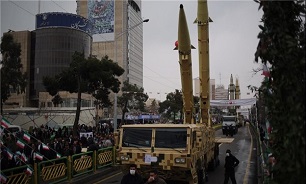IRGC Displays Ballistic, Cruise Missiles during Nationwide Feb.11 Rallies
 Millions of Iranians in Tehran and other cities throughout the country poured to the streets on Monday to show their unconditional support for the Islamic Republic through staging massive rallies on February 11th.
Millions of Iranians in Tehran and other cities throughout the country poured to the streets on Monday to show their unconditional support for the Islamic Republic through staging massive rallies on February 11th.
Huge masses of people from all walks of life converged on streets and squares all over the country to express their support for the cause and ideals of the Islamic Revolution.
The IRGC displayed three of its latest ballistic and cruise missiles, namely Qadr, Qiam and Zolfaqar, during the rallies in Tehran.
Qadr is a 2000km-range, liquid-fuel and ballistic missile which can reach territories as far as Israel.
The missile can carry different types of ‘Blast’ and ‘MRV’ (Multiple Reentry Vehicle) payloads to destroy a range of targets. The new version of Qadr H can be launched from mobile platforms or silos in different positions and can escape missile defense shields due to their radar-evading capability.
Iran in September 2016 started mass-production of home-made Zolfaqar missile that carries a Multiple Re-entry Vehicle payload and can destroy targets in distances up to 700km in range with a zero margin of error.
Zolfaqar, the latest generation of Iran's mid-range missiles, which was unveiled during the nationwide parades of Armed Forces in September 2016, is capable of carrying MRV payloads and can rain down missiles on ground targets with a high level of precision-striking power.
Qiam missile is also capable of carrying different types of ‘Blast’ and ‘MRV’ payloads, and can destroy a wide range of targets. It can be launched from mobile platforms or silos in different positions and can escape missile defense shields due to its radar-evading capability.
Qiam is also a new type of surface-to-surface and cruise missile of Iran.
A sum of 6,500 Iranian and foreign journalists, reporters and photographers covered the Bahman 22 (February 11) rallies this year.
In Tehran, demonstrators then congregated at the Azadi Square, Tehran's main square and the site of major national rallies over the past four decades.
The nationwide rallies also prove to the world that the brave Iranian nation is fully ready to resist and challenge the enemies of the Islamic Republic.
Led by the Founder of the Revolution, Imam Khomeini, Iranians confronted the forces of US-proxy Mohammad-Reza Pahlavi in late 1977 to end his oppressive, cruel and autocratic rule over the country.
By December 1978, millions of Iranians would take to the streets in protest against the policies of the Shah on a regular basis.
Grand Ayatollah Ruhollah Khomeini returned from exile to Iran to be received by millions of cheering crowds after the departure of the Shah in mid-January 1979. Two weeks later, the country saw the victory of the Islamic Revolution.
The final collapse of the Shah's regime came on February 11 when the military renounced its loyalty to the Shah and joined the revolutionary forces.
On this day 40 years ago, people took to the streets to celebrate the collapse of the Pahlavi Dynasty and the emergence of the new era.
Message end/
